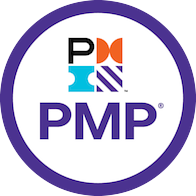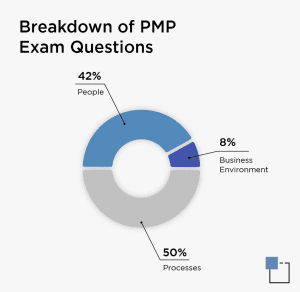
If you’re a project manager considering a Project Management Professional (PMP) certification, this article covers what it is, how to apply, PMP exam preparation, and more.
What Is a PMP?
The Project Management Professional (PMP) certification is an internationally recognized credential for project management professionals and is offered by the Project Management Institute (PMI).
PMP certification entails project management training in predictive project management, agile project management, and hybrid approaches. It is also applicable to project managers in a variety of industries.
Read more: Top 6 Reasons People Fail the PMP Exam
How to Get the PMP in 3 Steps
To get a PMP, there are a series of steps you need to take.
1. Apply to Take the PMP Certification Exam
First, gather and document your project management experience. Note where you led these projects, what your responsibilities were, and how long the projects took to complete. In addition, document all the training you’ve completed.
Note the institution where you undertook training, the courses you completed, and how many qualifying hours you’ve accrued.
The entrance fee to take the exam is
$405 for PMI members and
$555 for non-members. See if your employer can cover some (or all) of these fees.
2. Prepare for the PMP Certification Exam
Once you apply and pay the fee, you can schedule to take the PMP exam at a location near you, or take an online proctored exam from the convenience of your own home.
Once your PMP exam is scheduled and you receive your
study materials, like the Project Management Book of Knowledge (PMBOK), there are a number of ways you can prepare to ensure success when exam day arrives:
- Online exam prep courses (for an additional fee) with an authorized training partner
- Online exam prep on demand at your own pace
- Local study groups with a local PMI chapter
- Virtual support groups
- Practice exams to help you succeed on exam day
3. Stay Current on Your PMP Certification
Once you’re PMP certified, you can keep it current by enrolling in PMI’s Continuing Certification Requirements (CCR) Program. In this program, you accumulate and track professional development units (PDUs) over a three-year period. A PDU is one hour of time that you spend learning, teaching, or volunteering.
To remain current on your PMP certification, you’ll need to accumulate 60 PDUs over the course of three years after receiving your PMP certification. PMI provides a user-friendly online reporting tool to help you keep track of your progress.
Read more: Top 10 Best PMP Exam Simulators for 2022
PMP Eligibility Requirements
Before applying to get your PMP certification, make sure you meet the minimum eligibility criteria. There are two paths to becoming eligible:
- On the first path to eligibility, applicants must hold a four-year degree, have at least three years of project management experience, and 35 hours of project management education/training or CAPM certification.
- The second eligibility path requires that applicants have a high school diploma or associate’s degree, at least five years of project management experience, and 35 hours of project management education/training or CAPM certification.
What Is on the PMP Exam?

As of January 2021, the exam contains 180 questions that are broken down into three main components: People (42% of items on the exam), Process (50%), and Business Environment (8%). The exam questions are in a variety of formats, from multiple choice to fill-in-the-blank.
You get a total of 3 hours and 50 minutes to take the exam, along with two 10-minute breaks.
People
These questions on the PMP certification exam are related to people, targeting leadership and team-building skills, conflict resolution, how to support virtual teams, mentoring skills, and other topics related to interpersonal dynamics.
Process
The process section tests your knowledge on the methodologies of project completion, as well as your ability to manage budgets, change, scheduling, and other aspects of project management.
Business Environment
As a project manager, your responsibilities play into broader strategic business goals. It’s therefore necessary to train yourself in various aspects of the business environment, such as compliance, value streams, and organizational change/structure.
Benefits of a PMP
For project managers that qualify, PMP certification is well worth pursuing. PMP credential holders can enjoy the following benefits:
- New professional opportunities
- New skills
- Higher earning potential (average of 16% increase in median salary)
- Membership in an international professional community that spans 200+ countries
- Knowledge of latest, best practices in the field
When to Get a PMP
If you’ve been in the project management field for a few years, are ready to level up in your professional development and remain competitive, it’s worth looking into getting a PMP certification from PMI. What’s more, your employer may partially or completely subsidize the cost.
Read next: Strategy for Project Managers 2022 If you’re a project manager considering a Project Management Professional (PMP) certification, this article covers what it is, how to apply, PMP exam preparation, and more.
If you’re a project manager considering a Project Management Professional (PMP) certification, this article covers what it is, how to apply, PMP exam preparation, and more.
 As of January 2021, the exam contains 180 questions that are broken down into three main components: People (42% of items on the exam), Process (50%), and Business Environment (8%). The exam questions are in a variety of formats, from multiple choice to fill-in-the-blank.
You get a total of 3 hours and 50 minutes to take the exam, along with two 10-minute breaks.
As of January 2021, the exam contains 180 questions that are broken down into three main components: People (42% of items on the exam), Process (50%), and Business Environment (8%). The exam questions are in a variety of formats, from multiple choice to fill-in-the-blank.
You get a total of 3 hours and 50 minutes to take the exam, along with two 10-minute breaks.





